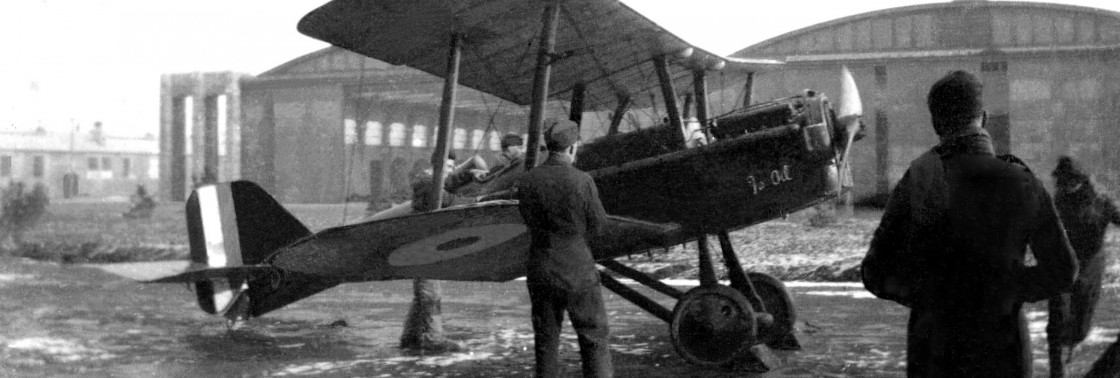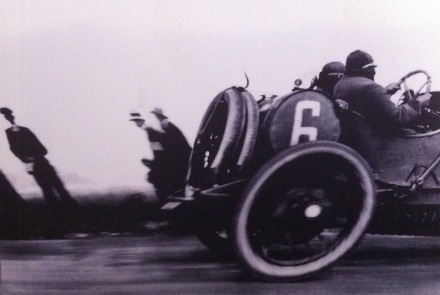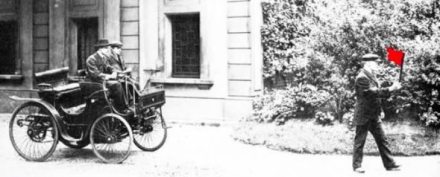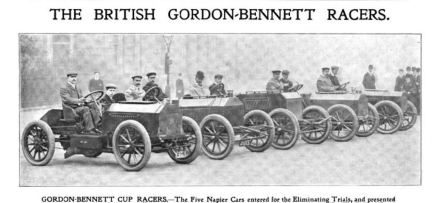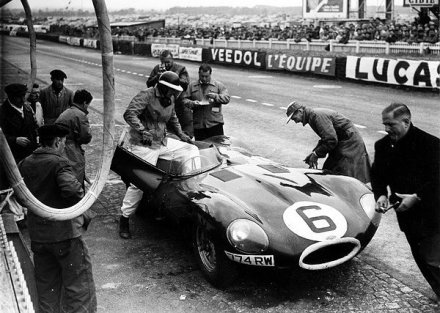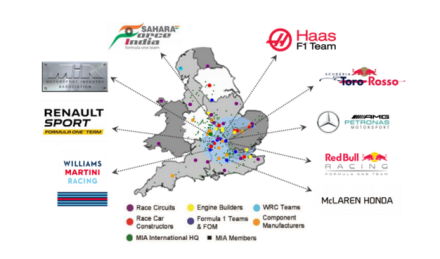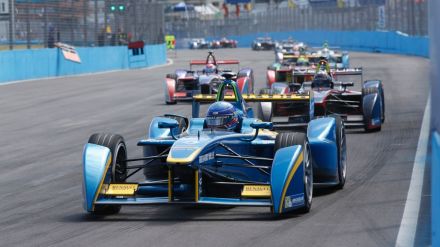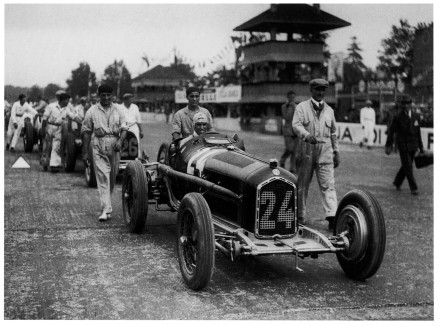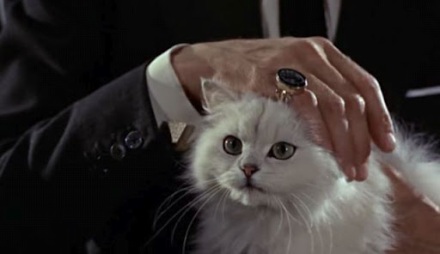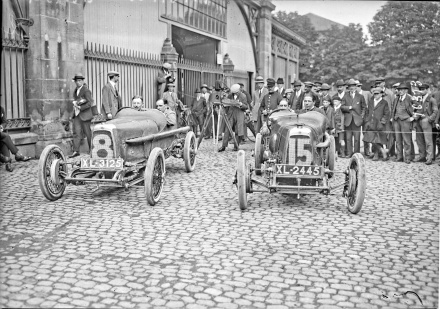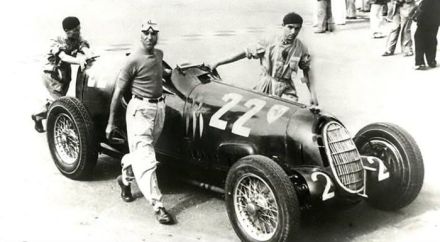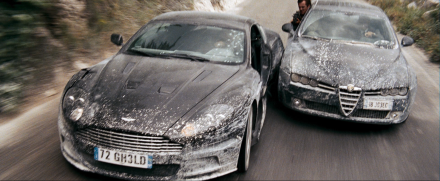The website of the Unitarian Universalist Church of Sarasota is not the first place one would think of looking at when seeking out members of the rip-roaring Grand Prix racing community of the 1950s.
And yet here is a profile of a trustee of the church who is in charge of Sunday Services; who rounds up ushers and greeters for duty every Sunday morning and hosts a monthly discussion group about movies. Not very F1, perhaps, but the photograph of a twinkly-eyed lady with an elfin haircut gives the game away… this is indeed the widow of that great British racer, Peter Collins.

Peter Collins and his wife Louise entertain ‘Fon’ de Portago (l) and ‘Taffy’ von Trips (r)
The story of Peter Collins is too rarely retold. This dashing young man with the carefree approach to life cut a swathe through the racing scene in the 1950s alongside such contemporaries as Sir Stirling Moss, Tony Brooks and Roy Salvadori – although he is best remembered for his symbiotic partnership with Mike Hawthorn in which each christened the other ‘mon ami mate’.
Born in Kidderminster in 1931, Collins’ father owned a garage and a haulage company, and to no great surprise young Peter developed an affinity for mechanical things very early on. As a teenager he thrived in the rough and tumble of 500cc racing on abandoned airfields alongside the likes of Moss and a certain Bernard Ecclestone.

The rakish young Collins gets ready for action
At a party hosted by the great pre-war lady racer Kay Petre in 1951, Collins managed to inveigle himself with the Aston Martin sports car team boss, John Wyer, and earned a test drive. On the appointed day at Silverstone not only was Aston present but also the HWM Formula 2 team – and by the time the teams were packing up to go home, Collins had a contract with both!
Throughout the first half of the 1950s Collins was a stalwart performer for the Aston Martin team in endurance racing and rallies. He also kept trying to break into Formula One with the British teams BRM and Vanwall but without great success, while first Hawthorn then Moss took the Grand Prix world by storm.
Finally Collins got his big chance when Moss requested that his old 500cc sparring partner be drafted in by Mercedes-Benz to partner him in the 1955 Targa Florio. They won the race and Collins found himself signing a contract for 1956 with none other than Enzo Ferrari.
Formula One drivers were expected to compete elsewhere, which meant that Collins’ first landmark result with the Scuderia came not at a grand prix but with second place on the Mille Miglia. Nevertheless this was swiftly followed by victories in both the Belgian and French Grands Prix, and these early days earned him the unstinting admiration of the ‘Old Man’, devastated by the untimely death of his son, Dino, and who turned to Collins for solace, treating him as a member of the family.

Ferrari holds court with Collins (r), Musso (l) and Castelotti
Meanwhile those mid-season victories ensured that the championship boiled down to a two-way fight between Collins and his three-time world champion team-mate Juan Manuel Fangio. At the final round, the Italian Grand Prix, Fangio’s car suffered a steering failure and left Collins with a clear run to the title – only for the young Englishman to voluntarily pull in and give his car to the older man, whose second place finish sealed his fourth title.
“It’s too early for me to become world champion – I’m too young,” Collins said afterwards. “I want to go on enjoying life and racing, but if I become world champion now I would have all the obligations that go with it. And Fangio deserves it anyway!”
This was astonishing behaviour, even by the more sportsmanlike days of the 1950s. As even Fangio admitted later, if the position had been reversed, nothing on Earth would have persuaded him to get out of that car.
Yet Collins was happy and after the clamour of his first season at Ferrari came the enjoyment of some leisure time. Each winter the drivers kept themselves busy – and earning money – with off-season appearances in the Americas and at the Nassau Speed Week. They also pursued their other great interest in life – women. It was in January 1957 that Stirling Moss told Collins about a beautiful girl he knew in Miami who loved grand prix racing – an actress called Louise King – and gave his old pal her number if he was at a loose end while in the States.

As close off the track as on it: Collins leads Moss at Silverstone, 1956
In fact Collins had met Louise at Monaco the previous year. Evidently this fact slipped his mind as he stood waiting for his ‘blind date’ at the Coconut Grove Playhouse bar and got talking to a bright young thing – who turned out to be the very girl he was waiting for all along. Not only did Collins get away with this gaffe, it was the start of something special.
As you can doubtless tell, Louise was no ordinary girl. The 24-year-old beauty was starring in the Broadway production of The Seven Year Itch alongside Tom Ewell, the star of the movie adaptation alongside Marilyn Monroe. The independent daughter of a distinguished diplomat, not only did the young divorcee willingly spurn Hollywood’s advances, but she was also an Austin-Healey driving member of the Sports Car Club of America with a passion for motor racing. It’s hardly surprising that Collins was besotted.

Collins and Louise relax by the pool between races
Two days after their first date, Louise lay next to Collins beside his hotel pool in Miami. It was at this moment that, whispering so that his friend, the American driver Masten Gregory, didn’t overhear, that Collins proposed – and Louise accepted. They were married the following Monday, to widespread disbelief.
Although Louise’s father was quickly won over by Collins’s natural charm, his own parents were appalled by the prospect of their beloved son marrying an actress, never mind that she was already once divorced and, as the last straw, an American.
His friends in the motor racing set however were astonished that Collins, a legendary swordsman, was seemingly going to turn down the pleasures of the many available – and occasionally unavailable – women with whom he had previously wiled away the hours. There was, by general consensus, more chance of Moss joining a monastery or Hawthorn going teetotal.

Few in the paddock believed Collins could adapt to domestic bliss
It was also widely expected that Enzo Ferrari would take this turn of events worst of all. He had lavished Collins with a paternal care in an era when drivers took lives in their hands on every lap and it was assumed that Ferrari would feel that a man with priorities off the track was never going to give him 100% commitment – but in fact the reverse was true.
The newlyweds were made welcome by Ferrari and his wife, Laura, who insisted on accompanying the glamorous new girl on every shopping trip and lunch date despite her complete lack of English and Louise’s equal lack of Italian. Initially they took a room in the old farmhouse above the Cavallino restaurant, but that summer they were gifted the use of an old villa on the factory grounds which had lain empty since the war.
For 1957 Fangio chose to rejoin his friends at Maserati and, when Eugenio Castelotti was killed in pre-season testing, Collins was the established star. He was teamed with the returning Mike Hawthorn, Italian driver Luigi Musso and Spanish nobleman Alfonso de Portago but it was to be a dismal season.

A publicity picture taken before the start of the fateful 1957 Mille Miglia
The greatest pall hung after the death of ‘Fon’ de Portago, together with his co-driver Ed Nelson and 10 spectators, in a crash on the Mille Miglia. The race continued, of course, with Collins leading for much of it until the transmission failed 130 miles from the finish. Recalling that night in Chris Nixon’s seminal book Mon Ami Mate, Louise said of Portago’s loss:
“…it was almost as though they expected it and although he was a very popular guy no-one could get upset about it. That night a group of us went out to to a restaurant and after dinner we danced the night away. We didn’t set out to go dancing. It was just a regular part of the evening at that restaurant and it provided a sense of release for us after the race.”
Death was an ever-present part of life as a racing driver, and therefore of life as a racing driver’s wife. The Collinses and the rest of the sport moved on, and in Formula One the most memorable grand prix of the season came in Germany, when Hawthorn and Collins, lapping together, managed to get beaten by Fangio, who put in the drive of his life to regain a 40 second deficit.
“I motioned Peter to come alongside and pointed behind us with thumb down to indicate that Fangio seemed to be in trouble,” Hawthorn later recounted in his book, Challenge Me The Race.
“He nodded, put his thumb up, then pointed to me with one finger and then back to himself with two. He wanted me to win and was prepared to come second himself, which I thought was a very sporting gesture…”

Fangio has passed Collins and tracks Hawthorn, 1957 German GP
It was also a plan doomed to failure, brought about by Fangio’s last and most celebrated victory. Yet increasingly Collins’s attention was not on his sport. He was planning to build an ‘American-style’ home in England, to invest in the new Austin-Healey factory in Nassau and to opening a Ferrari dealership with his father. He also wanted children, and his aims for family life began to preoccupy him as the 1958 season loomed.
After the disappointing Lancia-derived 801 of 1957, the new Ferrari 246 Dino held plenty of promise. Yet in the opening rounds of 1958 Collins was off the pace next to Hawthorn and Musso. When, in April, he and Louise left Maranello to live instead on their yacht Mipooka, moored in Monaco, Enzo Ferrari was cut to the core by what he perceived to be treachery.

Louise at home aboard their yacht, the Mipooka, to Ferrari’s chagrin
At Le Mans for the 24 Hours, Collins shared a new Testarossa with Hawthorn, who joked that racing for so long was no fun and that they should break the car in time to be back in England for Sunday lunch. When the clutch overheated, Collins was forced to retire and Hawthorn’s prophecy came true – while the team was able to drive the ‘broken’ car back to the pits once the clutch had cooled sufficiently.
All this was fuel on the fires of intrigue at Maranello, and an enraged Enzo Ferrari turned to Musso as the stick with which to beat the ungrateful young Englishman.

Collins at speed in the 1958 British GP – his last victory
Both Collins and Musso retired from the Belgian Grand Prix but in France it seemed that Musso was thoroughly wound-up to win at any cost. Ferrari initially forbade Collins from driving in the main race but later relented. Nevertheless Reims was a circuit on which the lionhearted Hawthorn thrived and he claimed victory for the Scuderia while the tragic Musso crashed fatally while trying to keep up.
The British Grand Prix saw the return of the old Peter Collins. Perhaps inspired by Ferrari’s attempt to drop him from in France, he was simply unbeatable despite the presence of both Hawthorn and the Vanwall of Stirling Moss… with much talk of the 1959 season, it seemed that Collins was now firmly back in the saddle at Ferrari.

To the victor, the spoils: Hawthorn and Collins celebrate Silverstone success
The next stop was the Nürburgring one week later for the German Grand Prix. Initially Moss led but his Vanwall’s magneto broke, leaving Hawthorn and Collins out in front from a charging Tony Brooks in the second Vanwall, who duly caught and passed them.
Determined not to be caught napping twice at the ‘Ring, the two Ferraris fought back but at Pflanzgarten Collins ran wide, hit the earth bank and was catapulted from his car as it somersaulted through the air. He was thrown head-first into a tree and did not survive the journey to hospital.
Louise’s 18-month fairytale ended as abruptly as it started. The Collins family lost no time in getting her to sign over any claim to her late husband’s estate and, in the depths of mourning, her friend Peter Ustinov scooped her up and put her on tour with him in Romanoff and Juliet as a distraction while ‘mon ami mate’ Hawthorn raced on to claim the world championship.

Louise still delights that, in Marilyn’s arms, Tom Ewell’s eyes are on her!
By 1959 she was back in America and back in the spotlight, becoming a regular on TV staples What’s My Line and the Today show. Eventually she stepped away from showbiz, finding new avenues as a real estate broker in New York City and Connecticut before retiring to Florida almost 20 years ago.
It seems unfair that so rich and varied a life as that of Louise King can be so defined on this blog by 18 months spent as the wife of a racing driver. And yet perhaps not. For her part, Louise remains staunchly proud of the life she shared with Peter Collins, the man she still describes as ‘the great love of my life’.
This summer will mark the 55th anniversary of that fateful German Grand Prix, and doubtless there will be many heartfelt prayers said in a certain church in a corner of Florida. And we should raise a glass to the brief, bright lives of the two ‘mon ami mates’ and the ongoing good health of their ‘mon ami matess’, Louise King.

The former Mrs. Collins, today a pillar of the church in Sarasota
